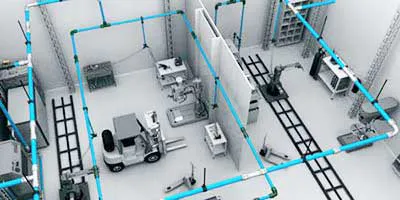Training
The four main types of compressed air dryers are refrigerated, chemical, desiccant, and membrane. It is important to understand how each drying technology works to learn which is best for your application.
Refrigerated dryers work by cooling the air to low temperatures and condensing much of the water vapor. It is not possible to achieve dew points below freezing with a refrigerated dryer. Optimally designed refrigerated dryers can produce air with dew points to approximately 36°F (2°C). Since some water vapor is left in the air, these dryers should not be used in water sensitive applications.
Chemical dryers use a process of passing the compressed air over beds of chemicals, typically calcium chloride and lithium chloride, which attract the water vapor. The chemicals become saturated with water vapor and are discarded. The lowest dew point achievable with this type of dryer is 27°F (15°C). Installation of a high efficiency coalescing filter upstream from the chemical dryer is essential because the life of the chemicals is significantly reduced if liquid water enters the dryer. A particle removal filter is needed downstream to prevent carryover of the chemical particles.
Desiccant dryers pass the compressed air over a bed of desiccant material which absorbs water vapor molecules. When the bed capacity is nearly saturated, the air flow is switched to a second bed of desiccant material. The first bed is then regenerated. Timers or dew point monitoring equipment can be used to control the regeneration phase. Desiccant dryers can deliver air at consistently low dew points, typically -40°F/°C or less. This technology is a good choice when the compressed air is subject to freezing conditions. There are two types of desiccant dryers: heated and heatless. Heated desiccant dryers use heat to remove water vapor from the desiccant material not in use at that point in the cycle. These dryers need large amounts of steam or electricity to operate. Heatless desiccant dryers use the dry air generated by the dryer to remove water vapor from the desiccant material. The major advantage of this technology is the reduced dependence on excessive outside services (e.g., steam, electricity, or gas) for heat. A regenerative desiccant dryer can be conveniently located near the point-of-use to deliver dry compressed air at dew points to -100°F (-73°C). Heatless desiccant dryers are ideal for delivering instrument quality air for critical applications.
Membrane air dryers use specially formulated membrane microtubes that are selectively permeable to water vapor. The microtubes provide an excellent medium for producing dry air from standard compressed air. As the compressed air travels along the length of the membrane, water vapor diffuses through the membrane, producing clean, dry compressed air at the outlet. A small fraction of the dry air is then directed along the outside surface of the membrane to sweep the moisture-laden air away from the membrane. These dryers can reduce the dew point of compressed air to as low as -40°F/°C. Membrane dryers are designed with no moving parts and no requirement for electrical supply. They operate with very little noise output - just a small amount of purge air is emitted through small exhaust ports. Membrane dryers require minimal maintenance and are inherently explosion proof. They are ideal for remote areas, explosive environments, sub-freezing environments, and applications requiring a consistent dew point.
Tips on specifying the right compressed air dryer:
To specify the right dryer for a compressed air installation, keep the following information in mind:
- Do not overspecify. Drying the entire compressed air supply in a factory to dew points less than -40°F (-40°C) is wasteful. It is more sensible to subdivide the compressed air supply by application, treating each point of use as needed to provide appropriately dry air for the downstream application served.
- Do not underspecify. Damage caused by wet air results in costly maintenance, downtime, and lost product. It’s best to design a drying system to meet specific needs.
- A drying system that only contains an aftercooler and a coalescing filter could create problems with condensation downstream from the aftercooler. The air is still saturated with vapor which is likely to condense when the ambient temperature is lower than the compressed air temperature.
- Take advantage of the "drying" effect of pressure reduction. For applications that use air at lower pressures than the main compressed air line and that tolerate some water vapor, install filters or filter regulators at the point of use to maximize the “drying” effect of pressure reduction.
- Specify membrane dryers for those parts of the system that require dew points of 35°F to 52°F (2°C to 11°C) and flow rates up to 600 scfm (17 NM3/min). Membrane dryers can also be used for applications requiring instrument quality air, air exposed to freezing temperatures, and water-sensitive applications requiring flow rates up to 100 scfm. Typically, compressed air with a dew point of -40°F (-40°C) is reasonable for these applications that are sensitive to water vapor.
- For applications requiring flow rates over 100 scfm and dew points lower than -40°F/°C, a desiccant dryer should be used.
Our knowledgeable sales staff is here to help you find the right product to fit the job and at the right price to fit your budget.
Contact us today at 727-835-0649 or Toll Free 800-761-4298.
Also Available from mdi: Parker Transair Aluminum Pipe and Fittings for Compressed Air
Transair aluminum pipe is the ideal system for compressed air, vacuum, and inert gas applications. It offers significant savings on installation, maintenance and operating costs when compared to traditional compressed air piping systems. Its removable and interchangeable components allow users to easily modify production layouts or execute process changes within minutes. It's the only product with true push-to-connect fittings, eliminating the need to thread, solder or glue pipe. Its unique sealing technology guarantees Transair to be leak-free.
Continue...
